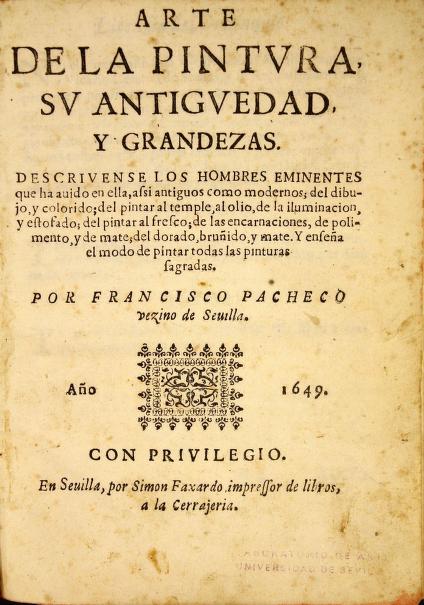
Frostispiece of Pacheco, El Arte de la pintura (1649), Seville, Simon Faxardo, impressor de libros, a la Cerrajeria
Concerning the representation of Archangel St. Michael, Pacheco is clear: is an inadequate manner to depict the St. without a weight scale. Such an element is considered essential to connect with the St.’s role, which is to help the common people to understand that it has the power to receive men’s souls and weigh their merits: “Although it is not excused to say something of the common insignia that is painted, which is the weight scale, of which Molano treated at length, which is painted so that the ignorant may understand that it has the power to receive the souls of men and to weigh their merits, […] Next to the lowest scales is painted the Devil who wants to take the soul, signifying that he is the slanderer and prosecutor of men who have done evil deeds […] (Pacheco 1990, 660)”.
“Of the painting of the archangel St. Michael, prince of the heavenly militia, we had to treat before the paintings of the other St.s, and this will be found in the third chapter of the second book, where a painting of the Last Judgement is described, and also in the painting of the angels in chapter II of this third book, with which we will avoid repeating some of the same things; although it is not necessary to say anything about the common insignia that is painted, which is the weight, of which Molano spoke at length, which is painted so that the ignorant may understand that it has the power to receive the souls of men and to weigh their merits. […]. Next to the lowest scales is painted the Devil who wants to take the soul, signifying that he is the slanderer and prosecutor of men who have done evil deeds; but the most famous painting of St. Michael is when he is painted fighting with the Devil and when he defeated this dragon and knocked him down from heaven and all those who followed him […]. This is the prince who fought, in ancient times, against the King of Persia in defense of the people of God and is now the defender of the Church […]”.
“De la pintura del arcángel San Miguel, príncipe de la celestial milicia, habíamos de tratar antes de las pinturas de los demás santos, y ésta se hallará en el tercero capitulo del segundo libro, donde se describe un cuadro del Juicio final y, asimismo, en la pintura de los ángeles en el capítulo II deste libro tercero, con que escusaremos la repetición de unas mesmas cosas; si bien no se escusa decir algo de la insignia común que se le pinta, que es el peso, de que trató Molano largamente, el cual se pinta para que entiendan los ignorantes que tiene poder para recebir las almas de los hombres e pesar sus méritos, […]Pintase junto a la balanza más baxa el Demonio que quiere coger l’alma, significando que es calumniador y fiscal de los hombres que han hecho malas obras; pero, la más célebre pintura de San Miguel es cuando se pinta peleando con el Demonio y cuando venció este dragón y lo derribó del cielo y a todos los que lo siguieron […]. Este es el príncipe que peleó, antiguamente, contra el Rey de Persia en defensa del pueblo de Dios y ahora es el defensor de la Iglesia[…]”.
Pacheco 1990, 660, n. 1.



